2014 Hotel Waterpark Supply & Demand Update
April 10, 2014 – published by Hotel News Now and World Waterpark Magazine
The amount of indoor and outdoor waterpark square footage will grow at a faster rate in 2014 than in any year since the Great Recession. Twelve indoor waterpark resorts or standalone indoor waterparks will be opened or expanded in 2014 compared to 9 in 2013. The projected 370,000 new indoor square feet in 2014 dwarfs the 68,000 indoor square feet added in 2013. Eight private outdoor waterparks are projected to open in 2014 compared to 5 in 2013.
The World Waterpark Association estimated approximately 82.5 million attendees at North American waterparks during 2013, which compared to 85 million in 2012 and 82 million in 2011. The decline in 2013 is attributed to consistently poor weather through much of the United States in the first six weeks of the season. This estimate includes attendance at all municipal and private indoor and outdoor waterpark facilities in North America.
HL&A defines various waterparks the following ways:
An indoor waterpark resort is a lodging establishment containing an aquatic facility with a minimum of 10,000 square feet of indoor waterpark space inclusive of amenities such as slides, tubes, and a variety of indoor water play features.
A resort with an outdoor waterpark is a lodging establishment with an outdoor aquatic facility with three or more waterpark elements requiring lifeguards such as slides, lazy rivers, or wave pools.
A standalone indoor waterpark is an aquatic facility that is not attached to a lodging establishment with a minimum of 10,000 square feet of indoor waterpark space inclusive of amenities such as slides, tubes, and a variety of indoor water play features.
An outdoor waterpark is an outdoor aquatic facility with three or more water slides. It often also includes other water elements requiring lifeguards such as lazy rivers, surf simulators, or wave pools. These parks will often offer additional splash features for younger children.
2013 Waterpark Standings
The number of U.S. waterparks reached 834 by March 2014, with the majority being outdoor waterparks (most of which are municipal). This is an increase from our April 2013 industry overview of waterparks, which indicated there were 796 waterparks in the United States.
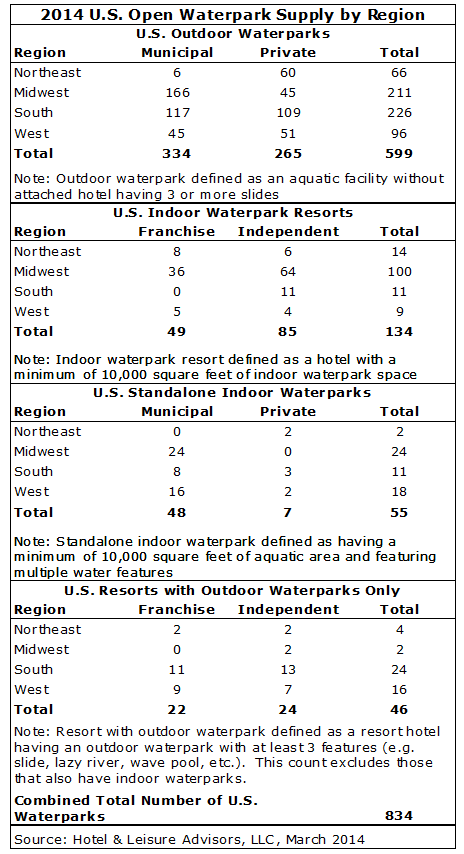
The Midwest is home to 337 waterparks, which is the greatest number of any U.S. region. The Midwest leads in the number of indoor waterpark resorts and standalone indoor waterparks and is a close second to the South for outdoor waterparks. The Midwest will continue its stronghold in 2014. Of the new indoor waterpark resorts and expansions scheduled, eight are in the Midwest, two in the Northeast, one in the West, and one in Canada.
Indoor Waterpark Resorts and Standalone Indoor Waterparks
Although indoor waterparks continued to grow and expand, square footage increases haven’t truly soared since 2008. (The high point was close to a 900,000 square foot increase in 2006). This year marks a great stride in the increase in overall square footage.
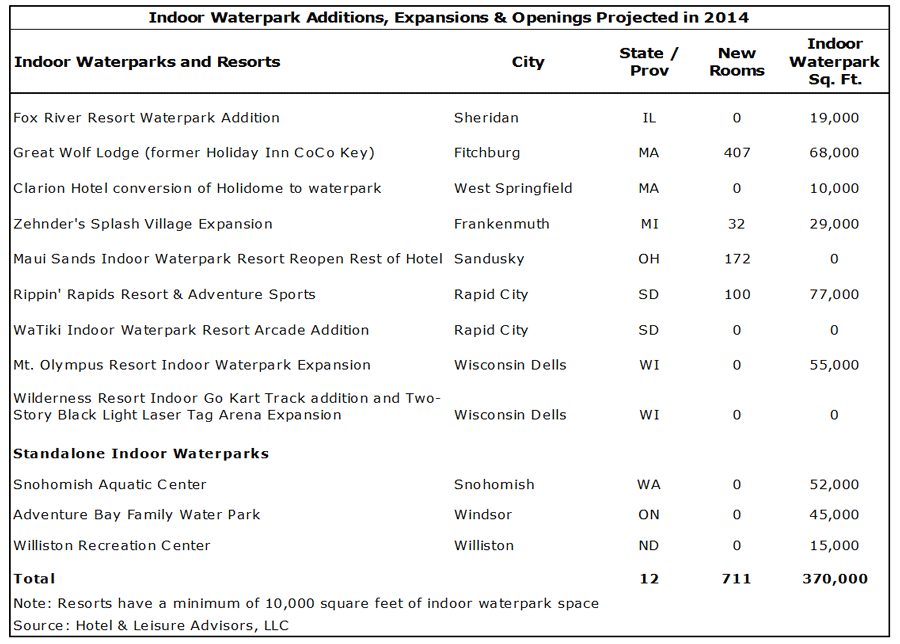
With 77,000 square feet of waterpark, Rippin’ Rapids Resort & Adventure Sports is the largest indoor waterpark projected to open in 2014. The South Dakota facility will feature waterslides, tubes, surf simulator, rock wall, zip lines, rope courses, and a 100-room hotel.
Following a closure and extensive renovation, the Great Wolf Lodge in Fitchburg, Massachusetts, will increase the number of hotel rooms at the former Holiday Inn from 245 to 407 and double the former CoCo Key waterpark in size to 68,000 square feet. The facility will also feature several dining options and more than 12,000 square feet of conference space.
Other significant projects include the Mt. Olympus Resort indoor waterpark expansion with 55,000 additional square feet and the new Snohomish Aquatic Center with 52,000 square feet. These larger projects are significant for 2014 growth as their sizes are larger than anything developed or expanded in 2013.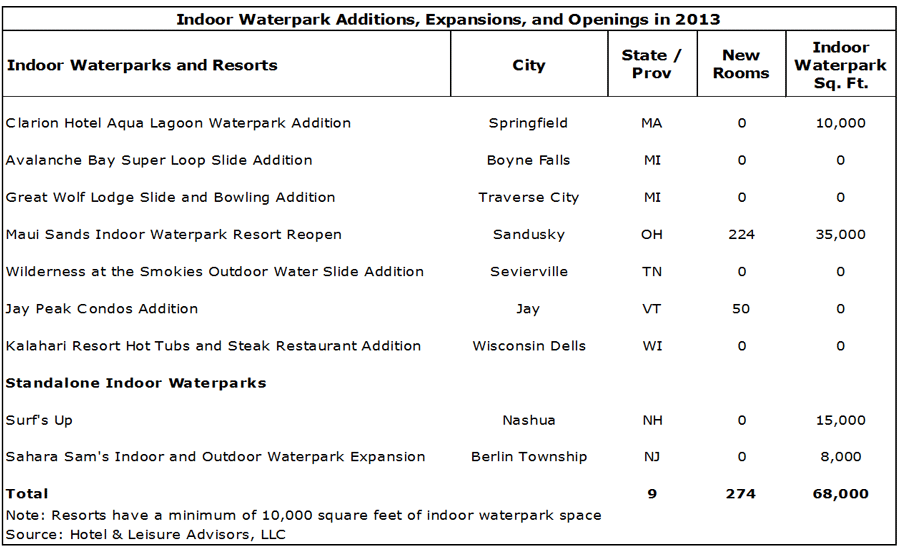
The largest indoor waterpark project last year was the reopening of Maui Sands in Sandusky, Ohio. It opened 224 rooms and 35,000 square feet of waterpark space in 2013. This year it is due to open the remaining 172 hotel rooms. In 2015, two major indoor waterpark destination resorts are due to open in the Poconos: the 453-room Camelback Resort and the 457-room Kalahari Resort, adding 220,000 square feet collectively.
Outdoor Waterparks
The U.S. supply of waterparks is dominated by outdoor waterparks. In 2014, another 15 are projected to open.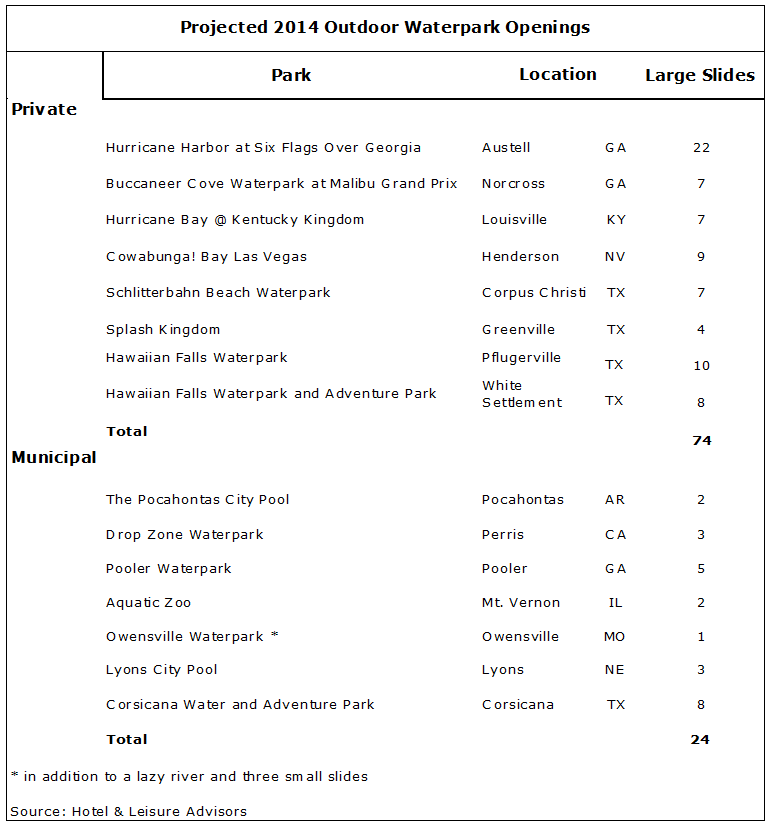
Seven municipal and 8 private waterparks are slated to open in 2014. We expect to learn of more municipal park openings throughout the year since sometimes they are only announced shortly before opening. As is typical, the private parks are significantly larger, with an average of 9 large slides planned compared an average of 3 large slides at the municipal parks.
Four of the 8 private outdoor waterparks will open in Texas. Two of the private parks will open in the Southeast, one in the Midwest, and one in the West.
In all, 98 new large slides at outdoor waterparks are slated to open in 2014. Smaller slides are often not announced prior to opening but contribute to a larger number of total slides reported by year-end.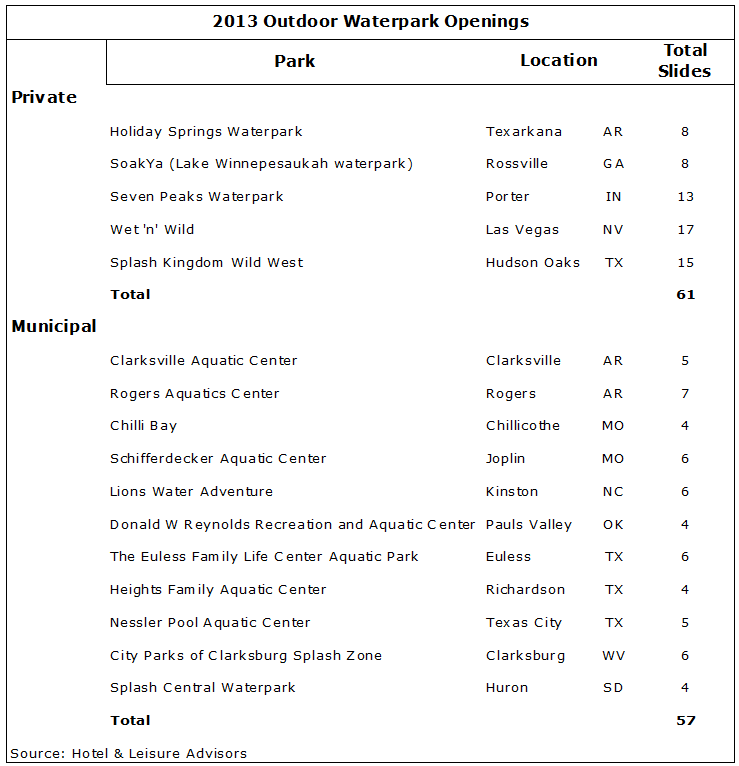
The majority of private waterparks that opened in 2013 were larger than the municipal ones that opened, averaging 12 slides each versus 5 slides at municipal parks. The outdoor waterparks opened with 118 total slides in 2013. The largest of these by number of slides was the Wet ‘n’ Wild Las Vegas waterpark. Other significant outdoor waterpark openings in 2013 include the 15 total slides at the Splash Kingdom Wild West in Hudson Oaks, Texas, and the 13 total slides at Seven Peaks in Porter, Indiana.
Resorts with Outdoor Waterparks
Outdoor waterparks can enhance a hotel’s amenities and attract additional guests. They may be the deciding factor when it comes to family lodging options. Three resorts with outdoor waterparks are slated to open or expand in 2014.

Legoland California opened as an amusement park in 1999, added a waterpark in 2010, and added a hotel in 2013. In 2014 it will expand its waterpark with a theme from its latest product line, Legends of Chima, where animal tribes battle in a fictional land for control of the energy source. The park will center on an interactive wave pool. There will also be a hands-on water play area with slides, cannons and water jets, and a build-a-boat area.
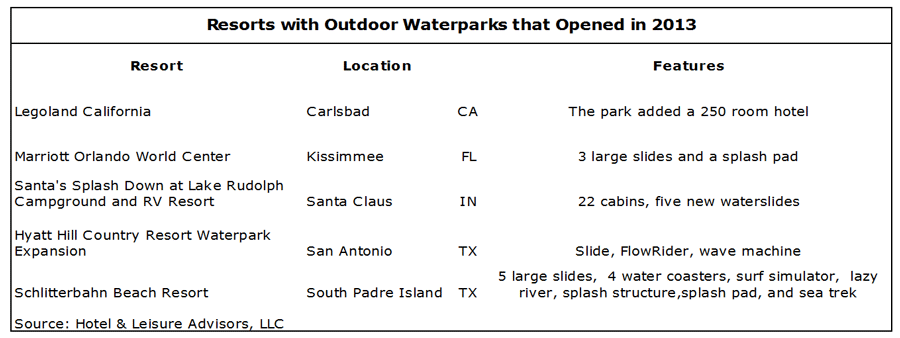
Marriott and Hyatt hotels and Lake Rudolph campground added outdoor waterparks to their properties in 2013. Lake Rudolph Campground and RV Resort in Indiana also added 22 cabins along. Legoland California and Schlitterbahn Beach Resort added hotels to existing waterparks.
Conclusion
The waterpark industry is showing real growth not only in the number of openings but also in the sizes, number of slides, and types of amenities. In 2014, we are finally beginning to see new project numbers that reflect those prior to 2009. The continued desire for fun, safe, family activities with a bit of adventure is reflected in the increasing demand for waterparks. More families are planning weekend getaways with their children’s desires in mind. Indoor waterpark destination resorts provide fun weekend and vacation getaways for families while outdoor waterparks typically attract more day guests from the surrounding area.
Although outdoor waterparks are less expensive to build, they are weather dependent and poor weather during the summer season can negatively impact financial results. Successful indoor waterpark resorts can yield much higher profits. However, not all ventures are successful, and funding is still challenging to obtain. Lack of funding is the main reason many proposed projects never see the light of day. Many factors contribute to a project’s success, and proper feasibility and economic impact studies, and planning are a must for any waterpark development. The development of an indoor or outdoor waterpark requires extensive research of supply and demand factors, demographics, income and expense levels, potential per capita spending, potential attendance, and profitability levels.